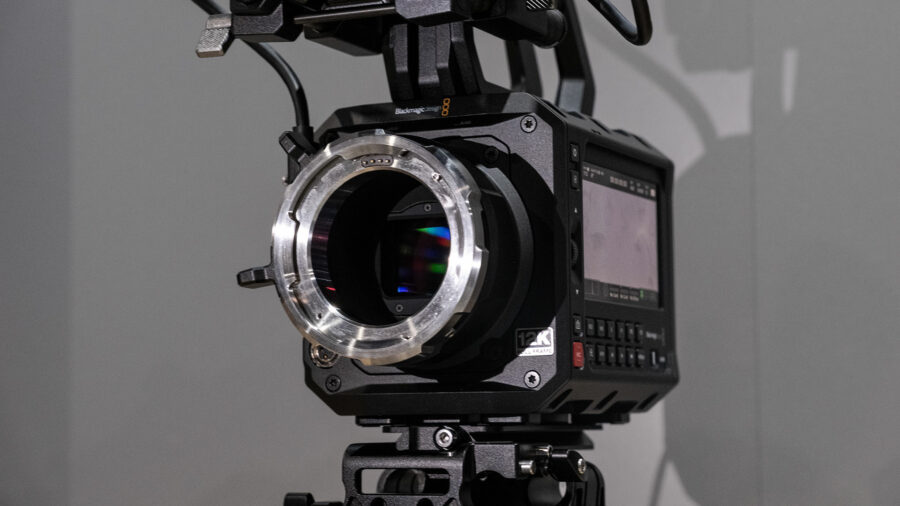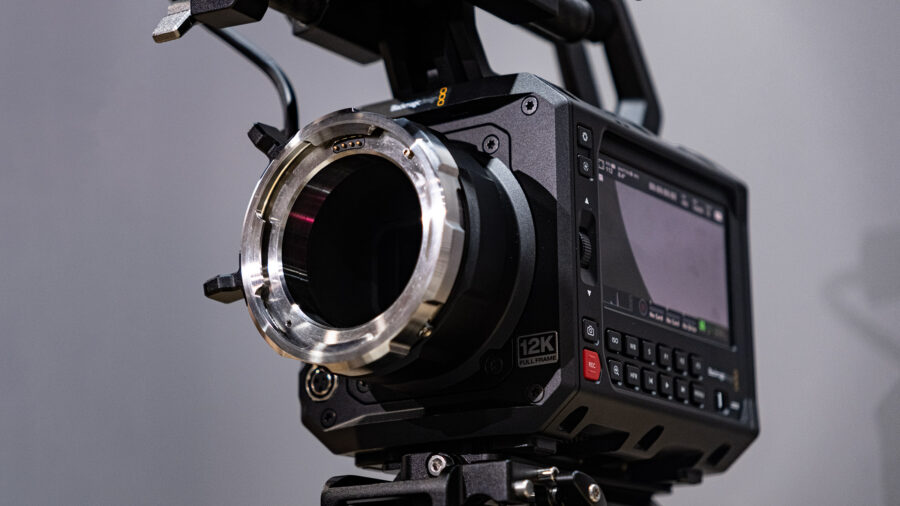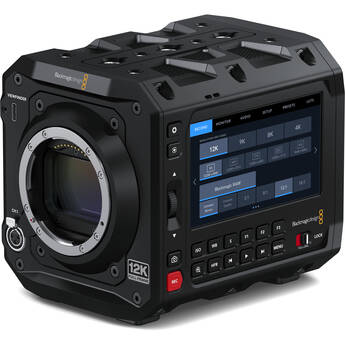Blackmagic PYXIS 12K Camera Explained in Video Interview
Since Blackmagic Design officially announced the new PYXIS 12K camera on Friday, it has been getting a lot of attention. We met with Craig Heffernan from Blackmagic Design right on the first day of NAB to ask him some important questions about the camera, many of which were inspired by your comments. We talked about RGBW sensor uncropped 4k recording, readout speeds, lack of internal ND filters, power draw, media, and more. Let’s dive into the Blackmagic PYXIS 12K details.
As Craig pointed out, the new Blackmagic PYXIS 12K has virtually the same camera body as the PYXIS 6K introduced last year. It features the same ergonomics, body, connectivity, side touchscreen display, three lens mount options (L, EF, PL), etc. Only this time, the camera sports the 12K full-frame RGBW sensor from the Blackmagic URSA Cine 12K.

RGBW versus Bayer sensors
One of the unique things about the new PYXIS 12K sensor is the RGBW technology, which allows for uncropped internal Blackmagic RAW video recording in various resolutions from full 12K down to 4K using the full width (and/or full height) of the sensor.
Compared to the Bayer sensor (which usually has to crop into the sensor when recording lower-resolution raw video), Blackmagic Design’s RGBW sensor offers a different kind of processing to provide full sensor readout. Craig explained that in the PIXYS 12K, this is not done through line skipping, but there is a different kind of processing happening. Without getting too technical here, Blackmagic Design claims the 4K image is more detailed than what a simple line skip image would have been. As a bonus, the available frame rates increase as the resolution goes down.
On top of multiple resolutions, the camera can also leave out the top and bottom sections of the sensor to offer even higher framerates – from open gate mode, down to 16:9, or even 2.4:1, depending on the needs of the production.
Sensor readout speed, rolling shutter performance
The readout speed of the 12K sensor in the PYXIS body is slightly reduced compared to the URSA Cine 12K camera. This is simply due to the fact that the URSA Cine offers faster image processing with better cooling. Craig told us the readout speeds are roughly double in each recording mode when compared to the URSA Cine 12K.

In fact, Blackmagic Design posted a helpful table on the BMD forum, which shows the readout speeds of various Blackmagic cameras. The PYXIS 12K manages 24.12-15.34ms in 12K and 13.51-8.59ms in 8K and 4K, depending on the aspect ratio (how many lines the camera has to read). Needless to say, we will perform our own tests in the CineD lab once the camera arrives in our office.
OLPF, IR cut, and no internal ND filters
We naturally had to ask Craig about the lack of internal ND filters, which many of our readers perceived as disappointing. As expected, he told us the camera body is identical to the PYXIS 6K, so it was not possible to fit an internal ND filter system in the camera without significantly changing the body design, increasing its price, and so on. He hopes this can get added to the next generation of BMD cameras.
The good thing is that just like the PYXIS 6K, the 12K also features an OLPF (Optical Low-Pass Filter) to reduce moire. The IR cut is now also matched to the 12K sensor.
Autofocus
As we heard on Friday during the announcement, the Blackmagic Cinema Camera 6K now has a capable autofocus with the latest firmware update (public beta); Blackmagic Design certainly is aiming to bring this capability to more cameras in the lineup. As Craig told us, however, there is still quite a lot of work to be done.
Currently, BMD wants to collect feedback on how the continuous phase-detection AF works in the BMCC 6K. The next logical step would be to bring the continuous AF for the original PYXIS 6K, as it uses the same sensor as the BMCC 6K.
The PYXIS 12K is, however, an entirely different sensor technology (RGBW versus Bayer), so bringing a capable phase detect AF to the 12K model will require a certain amount of engineering work. In other words, it might take some time.

Power consumption, media
First, the power consumption of the PYXIS 12K does not decrease when shooting in lower resolutions, as the camera always reads in 12K scan mode. Craig told us the camera takes between 60-80W of power depending on the current setup, accessories, etc.
The monitor and the EVF take roughly the same amount of power through that USB-C port. The USB-C connection is the same as with the PIXYS 6K, so you can connect either the Blackmagic EVF or the PYXIS monitor. There is no way to connect multiple screens to the one USB-C port.
In terms of media, there are two CFexpress slots and another USB-C port that can save the recorded footage to an external SSD. The bitrate of the least-compressed 12K recording mode is, however, fairly high, so it might cause some dropped frames if the used media is not fast enough and the internal cache is filled. The camera, thankfully, offers an option to stop recording if it detects a dropped frame.
Audio, gyroscope
Just like the 6K model, the PYXIS 12K is also limited to a single-channel audio input. The way I see it, this is more like a scratch audio channel to help sync the video footage to externally recorded high-quality audio (when not using timecode). Otherwise, the PYXIS cameras also feature a BNC timecode input port.
The PYXIS 12K sports a built-in gyroscope that records data for post-production stabilization. This is embedded as metadata directly in the recorded footage.
Price and availability
Blackmagic PYXIS 12K will ship in July 2025, and it can now be pre-ordered. As we already informed you in a separate article, the US price of the PYXIS 12K increased since the announcement by 32% in reaction to the newly imposed tariffs by the current US administration. The announced price of $4,995 has now been corrected to $6,595. In other regions, the price has remained the same, so in Europe, for instance, the PYXIS 12K can be pre-ordered for around €4,855 plus VAT.
Do you have experience working with the original Blackmagic PYXIS 6K camera or the URSA Cine 12K? What do you think about the new PYXIS 12K? Let us know your thoughts in the comments section underneath the article.



























